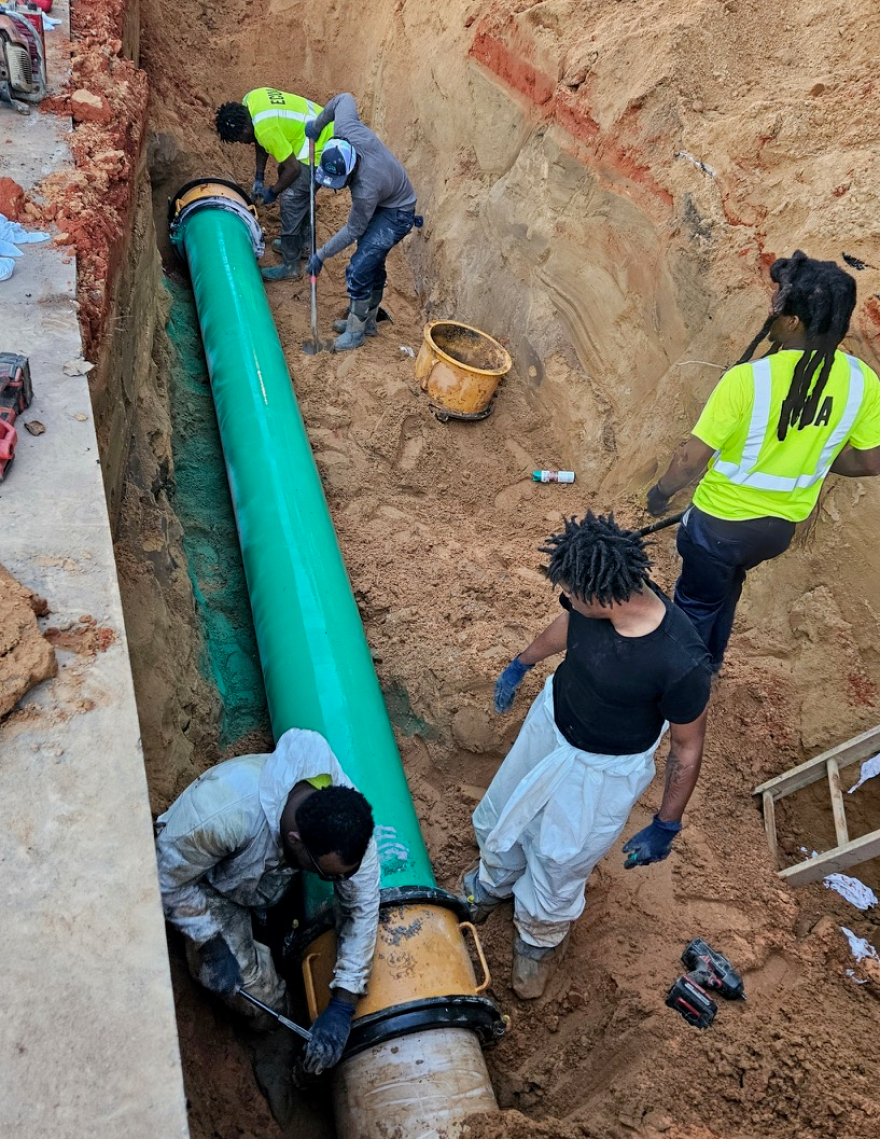For the seventh time this year, a sewage spill has contaminated waterways in Escambia County. On Saturday morning, an aging sewer line ruptured near the intersection of Scenic Highway and Olive Road, releasing an estimated 9,000 gallons of wastewater into Skinner Mill Creek, which flows directly into Escambia Bay.
Support Local Stories. Support Public Media.
The Emerald Coast Utilities Authority (ECUA) said the breach occurred in a 12-inch cast-iron force main. It's part of a pipeline now undergoing full replacement. ECUA Executive Director Bruce Woody said the spill was caused by pipe fatigue, not rainfall or stormwater intrusion.
"It’s a cast-iron pipe constructed in the late 1960s, early 1970s," explained Woody. "We’ve been actively working to replace nearly four miles of that pipe because it has reached the end of its useful life."
Crews responded to the spill within 30 minutes of ECUA receiving a report at 9:10 a.m. Saturday. Operators shut off and redirected the flow from upstream lift stations. Repairs were completed within four hours, said Woody.

A 20-foot section of the damaged line was replaced. To mitigate the environmental impact, ECUA flushed the area with 660,000 gallons of fresh water and used a vacuum truck to extract approximately 20,000 gallons of water from the creek. Woody noted that volume included rainwater and natural creek flow.
ECUA also deployed a neutralizing disinfectant intended to kill pathogens in the spilled wastewater.
Water quality samples were collected on Saturday from three locations: upstream of the discharge point, at the creek’s outfall into Escambia Bay, and downstream. Follow-up testing on Sunday morning showed that water quality had returned to normal levels, according to ECUA.
"This is a statewide requirement," Woody said. "Any time a spill enters a water body with potential public contact, we must monitor water quality until it returns to ambient conditions."
The rupture occurred in one of the last remaining segments of the old cast-iron line that serves the northeast portion of ECUA’s service area. The utility said it has accelerated its capital improvements program to complete the project by the end of August. Woody anticipates work may conclude several weeks early.
The final phase involves installing new PVC and high-density polyethylene (HDPE) pipe using a mix of open trench and directional boring methods. The overall project includes the replacement of over 20,000 linear feet of pipe. ECUA is investing $7.8 million into the effort. Woody said this section of pipeline is the sixth and final phase of a broader sewer infrastructure overhaul.
Asked whether ECUA faces potential fines from the Florida Department of Environmental Protection, Woody said that it is ultimately a state decision.
"Our concern first and foremost is for the environment and the folks affected," he said.
Saturday’s spill is not an isolated event. According to ECUA records and state environmental reports, this marks the seventh reported sanitary sewer overflow (SSO) in the county this year. At least two others involved the same force main, which ECUA has called one of the most challenging to access due to dense vegetation and a steep embankment leading to the stream bed.
In January and again in April, significant volumes of untreated sewage escaped into Skinner Mill Creek before reaching Escambia Bay. Emergency repairs cost ECUA roughly $200,000. The force main’s condition, along with its high-volume flow and difficult access, prompted the utility to prioritize full replacement.

The agency said this type of aging infrastructure challenge is not unique to Escambia County.
"It’s a problem across the United States," Woody said. "Our struggle is no different than anyone else’s. But we’re spending $35 to $40 million annually to upgrade our infrastructure, and this project is a good example of our commitment to protecting the environment."
Woody acknowledged that some residents are frustrated by repeated spills. He said the current replacement effort should give residents greater confidence in the system’s reliability going forward.
"This last section should put an end to problems from this particular series of force mains," he said.
The frequency of recent failures has surprised even ECUA veterans.
"This series of breaks is unprecedented for the ECUA," Woody said. "None of our long-term staff recall anything like this with a force main."
Though sewer line breaks can occur, Woody said they’re relatively rare, and about 50% result from damage by contractors, not infrastructure decay.
Woody also expressed regret that ECUA didn’t complete the work before the latest failure.
"We certainly wish we had gotten to this section of pipe before this occurred," he said. "But we are making the investment to make sure this doesn’t happen again."


